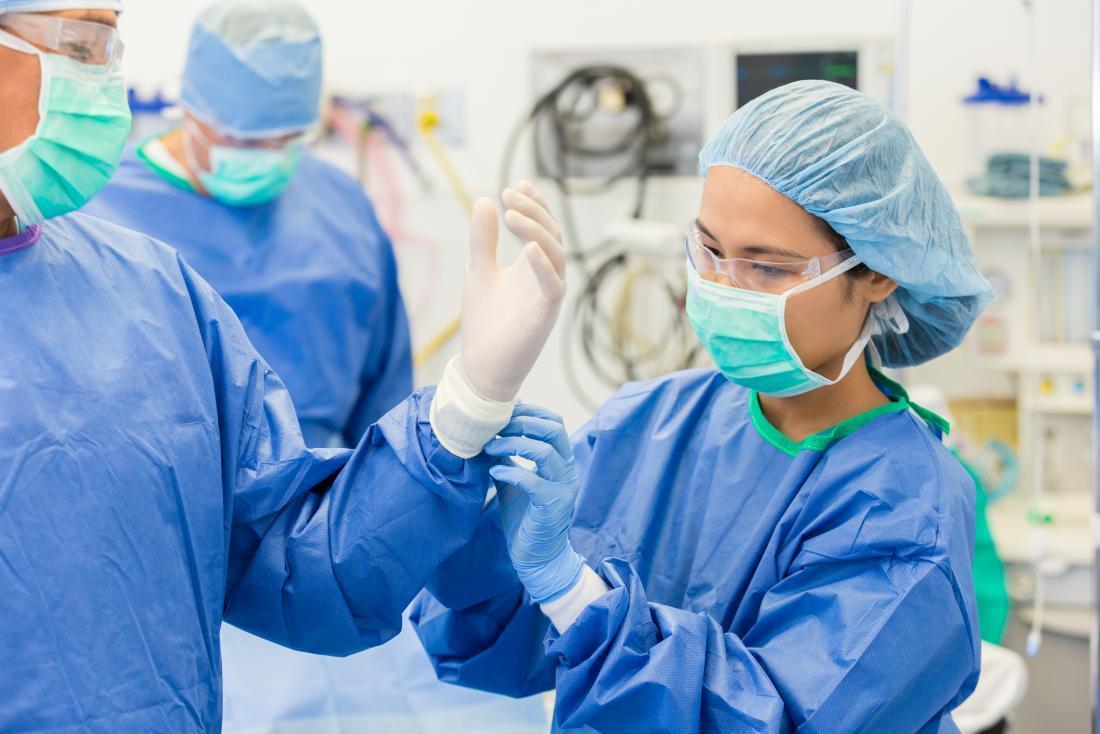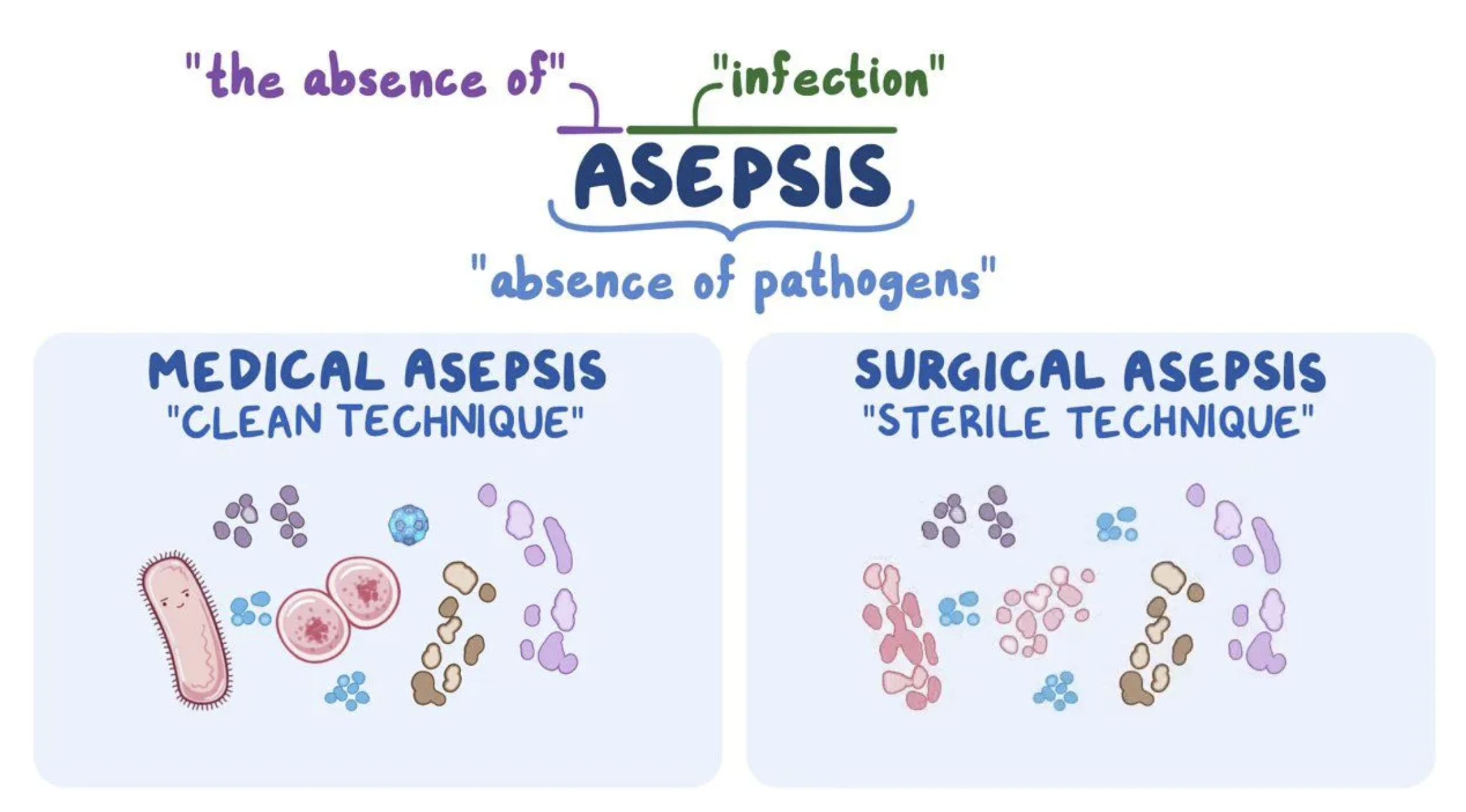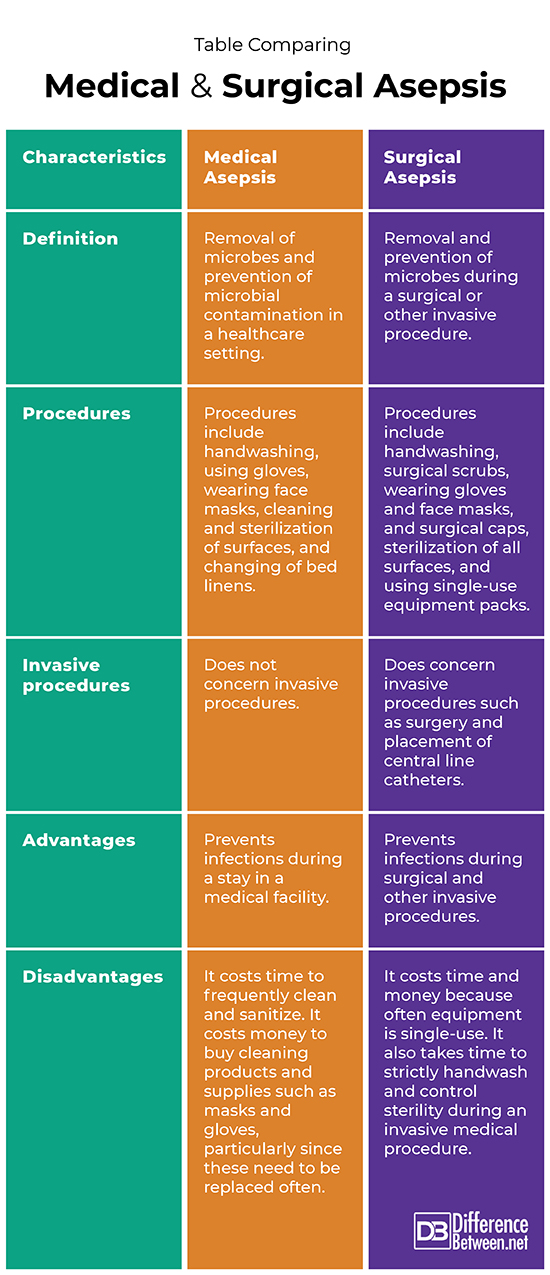Difference Between Medical and Surgical Asepsis
Medical asepsis includes the methods used in a general medical setting to reduce the spread of microbes and eliminate such contaminants. Surgical asepsis includes the methods used to eliminate microbes and maintain asepsis during an invasive or surgical procedure.

What is Medical Asepsis?
Definition:
Medical asepsis is the technique that is implemented in order to prevent contagion among patients and to rid a healthcare facility of any pathogenic organisms, such as bacteria and viruses that spread disease from person to person.
Procedures:
Medical asepsis techniques include frequent handwashing, using gloves and changing gloves often, cleaning and sterilizing medical equipment, and sanitizing surfaces. Beds in hospitals also need linens changed regularly. With Covid-19, it is now common for medical professionals in hospitals to also wear gowns and face masks in addition to gloves and to place Covid-19 patients in isolation units to further reduce the transmission of the virus.
Advantages:
The advantage of medical asepsis is that it helps reduce the incidence of nosocomial infections, which are those infections caught in a hospital or other healthcare facility. This helps stop people becoming sicker and potentially dying in the hospital.
Disadvantages:
It does cost money and time to perform medical asepsis, and hospitals have to budget for gowns, gloves, face masks, and cleaning and sanitizing supplies.

What is Surgical Asepsis?
Definition:
Surgical asepsis are techniques to ensure the absence of pathogenic and other, potentially harmful microbes during an invasive procedure such as surgery. An invasive procedure is any procedure in which entry is made into the body, for instance, placing a catheter or intubating a patient before surgery.
Procedures:
It is very important that sterile instruments and equipment are used, especially during invasive procedures where it is easy for microbes to gain access to the body. Usually prepacked sterile instruments are used that can be opened in the operating room, used during the surgical procedure, and then discarded. In surgery, everything above the waist is considered a sterile environment while everything below the waste is considered to be a not sterile environment. Surgeons have to carefully prepare by careful washing of the hands and then wearing PPE that includes gloves and surgical masks. Any instruments dropped on the floor cannot be used again due to becoming unsterile. Some equipment that is used in an operating room can be sterilized using a steam autoclave. The patient’s skin is also sterilized using various chemical agents, and the patient is draped and only the relevant areas of skin are exposed.
Advantages:
Surgical asepsis is important to prevent infection occurring due to invasive procedures, including the placing of catheters. It reduces healing time and decreases hospital-acquired infections by decreasing the likelihood of microbes entering the body from the external environment.
Disadvantages:
It takes more time to prepare for a surgery due to the needed precautions and sterilization methods that have to be carefully adhered to. Surgery is expensive and some of the cost is due to having to maintain high conditions of asepsis.
Difference between Medical and Surgical asepsis?
Definition
Medical asepsis is the removal and prevention of microbial contamination in a healthcare setting. Surgical asepsis is the removal and prevention of microbes during a surgical or other invasive procedure.
Procedures
Procedures involved in medical asepsis include: proper handwashing, wearing gloves and face masks, cleaning and sterilizing surfaces, and changing of bed linens. Procedures involved in surgical asepsis include, strict handwashing, wearing of surgical scrubs, gloves, masks, and surgical caps, sterilization of all surfaces, and the use of single-use equipment packs.
Invasive procedures
Medical asepsis is not involved in specific procedures that are invasive, such as surgeries. Surgical asepsis is involved in invasive procedures such as angiography, laparoscopic or open surgery methods.
Advantages
Medical asepsis is beneficial because it prevents the occurrence of hospital-acquired infections during a stay in a hospital. Surgical asepsis is beneficial because it prevents infection from occurring during an invasive procedure like a surgery.
Disadvantages
It can be costly in both money and time to maintain medical asepsis due to costs of supplies and chemicals. It can cost time and money to properly do surgical asepsis because single-use packs of equipment are often used and it takes a lot of preparation to maintain sterility.
Table comparing Medical and Surgical asepsis

Summary of Medical Vs. Surgical asepsis
- Medical and surgical asepsis are both methods that are used to eliminate infections by preventing microbial contamination.
- Medical and surgical asepsis both take time to do properly and also cost money because of the need to constantly buy new materials and disinfectants.
- Surgical asepsis includes techniques used during any of the invasive procedures that are routinely done in a hospital environment.
- Both types of asepsis, surgical and medical, aim to reduce nosocomial infections and deaths.
- Difference Between Rumination and Regurgitation - June 13, 2024
- Difference Between Pyelectasis and Hydronephrosis - June 4, 2024
- Difference Between Cellulitis and Erysipelas - June 1, 2024
Search DifferenceBetween.net :
Leave a Response
References :
[0]Editors of Encyclopaedia Britannica. “Surgery.” Medicine. Encyclopedia Britannica, 2021. https://www.britannica.com/science/surgery-medicine#ref78665
[1]Gruendemann, B. J. "Surgical asepsis revisited." Today's OR nurse 12.10 (1990): 10-14.
[2]Rizzari, Carmelo, et al. "Central venous catheter-related infections in pediatric hematology-oncology patients: role of home and hospital management." Pediatric hematology and oncology 9.2 (1992): 115-123.
[3]Image credit: https://d16qt3wv6xm098.cloudfront.net/cgeoS0z_StCDoIw8P8zCV8E8RYKfpWAg/_.jpg
[4]Image credit: https://i0.wp.com/cdn-prod.medicalnewstoday.com/content/images/articles/323/323615/surgeon-wearing-mask-protective-eyewear-hair-net-gown-and-helping-other-surgeon-with-sterile-gloves-before-operation.jpg?w=1155&h=1541
